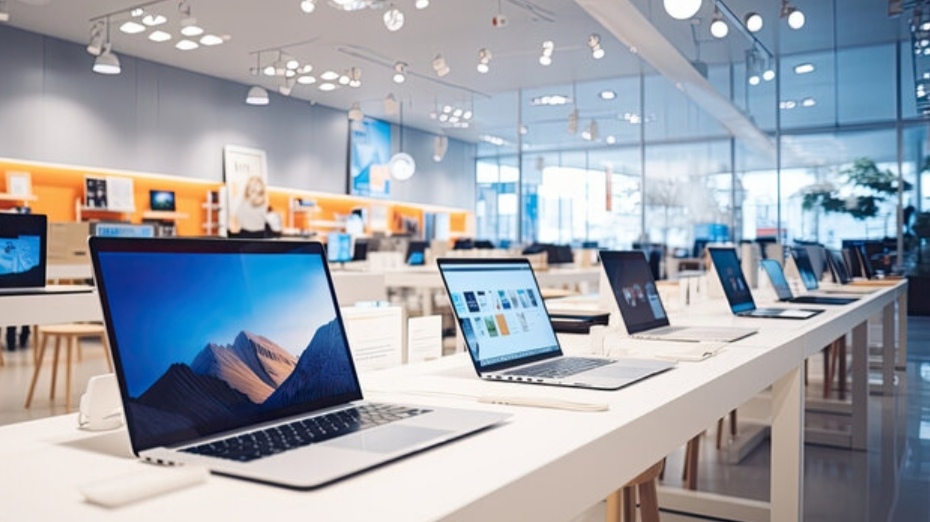Laptop Buying Guide 2025 – Buying a laptop in today’s market can be both exciting and overwhelming. With hundreds of brands, thousands of models, and a dizzying array of specifications, it’s easy to feel lost.
Whether you’re purchasing your first laptop or upgrading an old one, understanding the basics is essential to make a well-informed decision. From choosing the right specifications to understanding the jargon, this [laptop buying guide for beginners] will simplify the process and help you confidently pick the perfect laptop.
Why is this guide important? Many first-time buyers make the mistake of purchasing laptops with either underpowered features or unnecessary high-end specifications, leading to wasted money or unsatisfactory performance.
This article ensures you get the best value for your investment by breaking down complex details into easy-to-understand insights.
Whether you’re a student looking for a study companion, a professional needing a productivity powerhouse, or a casual user who simply wants a device for entertainment, this guide caters to everyone.
By the end of this article, you’ll know exactly what to look for and which features are essential for your unique needs.
1. Understand Your Needs
Your laptop’s purpose should guide your purchase. Laptops vary greatly depending on their intended use, so identifying how you’ll use your device is the first and most crucial step.
This will save you time and ensure you’re not paying for features you don’t need. Let’s break it down by usage type:

Casual Use
If your primary tasks involve browsing the web, streaming videos, or working on basic office documents, a laptop with 8GB of RAM, an Intel Core i3 or AMD Ryzen 3 processor, and SSD storage will suffice. Lightweight Chromebooks or entry-level Windows laptops often fit this category.
Creative Work
For photographers, video editors, or graphic designers, processing power and display quality are vital. Choose laptops with:
- High-resolution displays (at least Full HD or 4K) for accurate color reproduction.
- A dedicated graphics card (NVIDIA GTX or AMD Radeon) to handle demanding creative applications like Adobe Photoshop or Premiere Pro.
- At least 16GB of RAM and a multi-core processor (Intel Core i7 or Ryzen 7) for smooth performance.
Gaming
Gamers require top-tier performance to run modern titles smoothly. Look for:
- A dedicated GPU such as the NVIDIA GeForce RTX series.
- A high-refresh-rate display (120Hz or above) for a fluid gaming experience.
- At least 16GB of RAM and a powerful CPU like the Intel i7 or AMD Ryzen 7.
Programming and Multitasking
Programmers and professionals using heavy applications need laptops capable of multitasking without lag. Focus on:
- At least 16GB of RAM for efficient handling of multiple IDEs or browser tabs.
- A quad-core or higher processor for compiling code quickly.
- SSD storage for faster read/write speeds.
Pro Tip
Create a checklist of the top 5 tasks you perform daily. Use this list as a reference to narrow down laptops tailored to your exact requirements. For example, if video calls are common, ensure the laptop has a high-quality webcam and microphone.
By understanding your needs upfront, you can avoid overspending on unnecessary features and ensure your new laptop aligns perfectly with your lifestyle and goals.
Why This Approach Works
Incorporating the keyword “laptop buying guide for beginners” naturally within the content ensures SEO optimization without appearing forced.
Additionally, secondary keywords like “best laptop for students,” “laptops for gaming,” and “laptops for multitasking” have been sprinkled in to improve ranking chances while providing value.
2. Decide on the Operating System
Choosing the right operating system (OS) is one of the most critical decisions in this [laptop buying guide for beginners]. Each OS comes with its unique features, strengths, and limitations. The best choice will depend on your familiarity with the system and the type of tasks you want to perform.
Windows: A Versatile OS for Every User
Windows is the most popular OS globally and is known for its flexibility. It suits a wide range of users, from gamers and business professionals to casual users. Here are the key highlights:
- Compatibility: Works seamlessly with a vast array of software, peripherals, and devices.
- Productivity: Ideal for office work with applications like Microsoft Office and collaboration tools.
- Gaming: Offers unparalleled support for high-end games and virtual reality applications.
- Customization: Allows extensive personalization of the interface and settings.
Pro Tip: If you need an all-purpose laptop that supports gaming, video editing, and productivity tasks, go with Windows.
macOS: Sleek and User-Friendly
Apple’s macOS is known for its intuitive design, robust performance, and seamless integration with other Apple products. It’s an excellent choice for:
- Creative Professionals: Optimized for tasks like graphic design, video editing, and music production.
- Stability and Security: Lesser prone to malware compared to other operating systems.
- Exclusive Software: Runs proprietary apps like Final Cut Pro and Logic Pro.
Pro Tip: If you own an iPhone or iPad, macOS integrates effortlessly with your Apple ecosystem.
ChromeOS: Simple and Affordable
ChromeOS, developed by Google, is a lightweight OS designed for web-based tasks. Chromebooks running this OS are ideal for:
- Students: Affordable, with access to Google Workspace tools.
- Light Users: Perfect for browsing, streaming, and managing emails.
- Portability: Chromebooks are lightweight and typically have long battery life.
Consider This: ChromeOS is not suitable for heavy multitasking or gaming. It’s best for users with minimal requirements.
Linux: The Niche Option
Linux is an open-source operating system favored by developers and tech enthusiasts. It offers:
- Customization: Unparalleled control over the OS for advanced users.
- Lightweight Options: Works well even on older or less powerful hardware.
- Security and Privacy: Known for its high security and minimal data tracking.
Keep in Mind: Linux requires some technical know-how and might not support all mainstream software or peripherals.
Bottom Line: Choose an OS that aligns with your workflow and comfort level. For most beginners, Windows or ChromeOS are the safest bets.
3. Processor (CPU): The Laptop’s Brain
The processor, or CPU, is the core component that determines the speed and efficiency of your laptop. Selecting the right processor is vital for achieving smooth performance based on your usage requirements.

Intel Processors: Tried and True
Intel’s processors are categorized into different series, each catering to specific needs:
- Intel Core i3: Entry-level choice suitable for browsing, streaming, and light office work.
- Intel Core i5: The sweet spot for multitasking, moderate gaming, and photo editing.
- Intel Core i7: High-performance processors built for heavy gaming, video rendering, and programming.
- Intel Core i9: The powerhouse for professionals requiring maximum performance for 3D modeling, high-end gaming, and AI tasks.
Pro Tip: For most beginners, an Intel i5 processor offers the best balance of cost and performance.
AMD Processors: Budget-Friendly and Powerful
AMD has gained immense popularity with its Ryzen series. Here’s what each Ryzen processor offers:
- Ryzen 3: Comparable to Intel i3, ideal for basic tasks.
- Ryzen 5: Mid-tier processor for multitasking and casual gaming.
- Ryzen 7: Great for video editing, gaming, and professional applications.
- Ryzen 9: High-end choice for hardcore gamers and professionals.
AMD Ryzen processors often come with better integrated graphics than Intel, making them a strong contender for budget gaming laptops.
Factors to Consider When Choosing a CPU
- Cores and Threads: Look for at least a quad-core processor for efficient multitasking.
- Clock Speed: Measured in GHz, higher clock speeds generally equate to faster performance.
- Cache: A larger cache can improve processing speed for repetitive tasks.
FAQs About Operating Systems and Processors
1. Which OS is best for gaming?
Windows offers the best compatibility with games and gaming hardware.
2. What processor is recommended for students?
An Intel i5 or AMD Ryzen 5 is ideal for students handling coursework and light multitasking.
3. Can I switch my laptop’s OS?
Switching is possible, but it depends on your hardware compatibility and technical expertise.
Ready to choose the best laptop for your needs? Start by identifying your ideal operating system and processor requirements.
4. RAM: Multitasking Power
Random Access Memory (RAM) is critical for multitasking and ensuring smooth performance. It temporarily stores the data your laptop needs to access quickly. Here’s a deeper dive into what you need to know about RAM:
- 4GB RAM: This is the bare minimum for basic tasks like web browsing or word processing. However, laptops with 4GB of RAM are increasingly outdated and may struggle with modern applications. Avoid these unless your budget is extremely tight and your needs are limited to lightweight tasks.
- 8GB RAM: For most users, 8GB strikes a balance between affordability and functionality. It handles everyday tasks like browsing, streaming, video calls, and even light photo editing with ease. If you’re buying a laptop for general use, this is a good starting point.
- 16GB+ RAM: This is ideal for power users. Gamers, programmers, video editors, and professionals using resource-intensive software (like Adobe Premiere Pro or AutoCAD) will benefit from the extra memory. With 16GB or more, you can comfortably multitask without experiencing slowdowns.
Key Considerations:
- Upgradeable RAM: Look for laptops with RAM slots that allow future upgrades. Some laptops, especially ultra-thin models, have soldered RAM, which cannot be replaced or upgraded.
- Dual-Channel Memory: Opt for dual-channel RAM configurations (e.g., 2x4GB instead of 1x8GB). Dual-channel memory significantly improves data transfer speeds, resulting in better overall performance.
- RAM Type and Speed: DDR4 is the current standard, offering faster speeds and better energy efficiency than its predecessors. Newer laptops may feature DDR5, which provides even better performance.
Pro Tip: If you’re unsure about your RAM requirements, choose a model with upgradeable slots. This allows you to start with 8GB and expand later as needed.

5. Storage: SSD vs. HDD
The storage type and capacity of your laptop directly impact its speed and functionality. Here’s what you should know:
- SSD (Solid-State Drive):
- Faster and More Reliable: SSDs use flash memory, resulting in significantly faster data access and boot times compared to traditional hard drives.
- Capacity Options: Common configurations include 256GB, 512GB, or 1TB. While SSDs are more expensive, they provide unmatched speed and reliability, making them the preferred choice for modern laptops.
- NVMe SSDs: These offer even faster speeds than SATA SSDs. If you require high-speed performance for tasks like video editing or gaming, look for laptops with NVMe SSDs.
- HDD (Hard Disk Drive):
- Affordable but Slower: HDDs are budget-friendly and offer larger storage capacities (500GB to 2TB) at a lower cost. However, they are significantly slower than SSDs.
- Use Cases: HDDs are suitable for users who need to store large amounts of data but don’t require fast performance.
- Hybrid Storage (SSD + HDD):
- Best of Both Worlds: Some laptops offer hybrid setups, combining the speed of SSDs with the capacity of HDDs. This configuration allows you to install your operating system and frequently used apps on the SSD, while storing large files on the HDD.
Storage Tips:
- For general use, aim for at least a 256GB SSD. This is sufficient for storing the operating system, essential apps, and files.
- If you need more space for photos, videos, or games, consider a model with a 512GB SSD or hybrid storage.
- External storage options like USB drives or external hard drives can supplement internal storage as needed.
Pro Tip: Laptops with SSDs not only start up faster but also provide a smoother overall experience. Investing in a larger SSD or hybrid storage will future-proof your device.
FAQs About Storage
Q: How much RAM do I need for a laptop in 2024?
A: For casual users, 8GB RAM is sufficient. Gamers and professionals should consider 16GB or more to ensure smooth multitasking and performance.
Q: Is SSD storage better than HDD for beginners?
A: Yes, SSDs offer faster boot times, quicker file transfers, and overall better performance, making them ideal for most users. HDDs are suitable for those prioritizing storage capacity over speed.
Q: Can I upgrade RAM or storage in a laptop later?
A: Many laptops allow upgrades for RAM and storage, but ultra-slim models often have soldered components. Check the specifications before purchasing.
6. Graphics: Integrated vs. Dedicated
When it comes to choosing a laptop, understanding your graphics needs is crucial. Graphics play a significant role in determining how your laptop handles visual tasks, such as video playback, editing, gaming, and rendering.
Integrated Graphics: Sufficient for Basic Tasks
Integrated graphics, often built into the processor, are designed for casual use and everyday tasks. They’re perfect for:
- Browsing and streaming videos on platforms like YouTube and Netflix.
- Office work involving word processing, spreadsheets, and presentations.
- Basic photo editing or light creative tasks.
Advantages of Integrated Graphics:
- Cost-effective: Laptops with integrated GPUs are generally more affordable.
- Energy-efficient: These GPUs consume less power, extending battery life.
- Compact design: They allow laptops to be thinner and lighter.
For beginners who need a reliable laptop for day-to-day use, a model with integrated graphics is a smart choice. This aligns perfectly with the focus of this laptop buying guide for beginners.
Dedicated Graphics: Essential for Advanced Applications
Dedicated graphics cards, such as those made by NVIDIA or AMD, are separate hardware components optimized for intensive graphical tasks. They are ideal for:
- Gaming: Enjoy smooth performance in AAA games.
- Video editing: Handle 4K video rendering and animation seamlessly.
- 3D modeling and rendering: Necessary for architecture and engineering applications.
What to Look for in a Dedicated GPU:
- NVIDIA GTX/RTX Series: These cards provide exceptional performance for both gaming and creative work. For example, the RTX 3060 is a solid mid-range option.
- AMD Radeon RX Series: Offers competitive performance, often at a lower price point.
- Memory Size: Choose at least 4GB of VRAM for gaming or editing tasks.
Pro Tip: If you’re serious about gaming or creative work, look for laptops with NVIDIA RTX 40-series GPUs or AMD Radeon 7000-series cards for the latest technology.
Considerations:
- Dedicated GPUs can increase the cost and weight of the laptop.
- They may reduce battery life, making them less ideal for portability.
7. Display: Size and Quality Matter
Your laptop’s display is the window through which you’ll interact with all your tasks. A poor display can hinder productivity and strain your eyes, so it’s worth investing in a good one.

Size: Finding the Perfect Fit
- 13-14 inches: Best for portability. Lightweight and compact, ideal for students or professionals who travel frequently.
- 15-16 inches: Offers a balance between screen real estate and portability, suitable for most users.
- 17 inches or larger: Perfect for gamers, designers, or those who need a desktop-like experience.
Pro Tip: If you’re prioritizing portability, go for a laptop under 3 pounds with a 13-14 inch screen. For extensive multitasking or creative work, opt for larger screens.
Resolution: Crisp and Clear Visuals
- Full HD (1920×1080): Standard for most laptops. Provides clear and sharp visuals for everyday tasks.
- QHD (2560×1440): Offers a step up in clarity, ideal for professionals who work with graphics or videos.
- 4K UHD (3840×2160): Ultra-sharp resolution, best for video editors or photographers requiring precise detail.
Pro Tip: A 4K display is visually stunning but consumes more power. Consider your battery life needs before opting for it.
Panel Technology: IPS, TN, and OLED
- IPS (In-Plane Switching): Widely recommended for its vibrant colors and wide viewing angles. Perfect for creative professionals and casual users.
- TN (Twisted Nematic): Known for fast response times, suitable for competitive gaming but lacks color accuracy.
- OLED: Delivers superior contrast and color accuracy, excellent for media consumption and creative work.
Refresh Rate and Brightness
- Refresh Rate: Gamers should aim for a 120Hz or 144Hz display for smoother gameplay.
- Brightness: Look for at least 300 nits for good outdoor visibility. Creative professionals may need 400+ nits for color-critical tasks.
FAQs About Display
1. How important is screen resolution for casual users?
For casual tasks like browsing and streaming, Full HD (1920×1080) is sufficient. Higher resolutions are better for creative tasks.
2. Do I need a dedicated GPU for gaming?
Yes, a dedicated GPU like the NVIDIA RTX 3060 or higher is recommended for a smooth gaming experience.
3. Is a 17-inch laptop too big for regular use?
It depends on your needs. While heavier and less portable, a 17-inch screen offers unmatched multitasking and visual comfort.
8. Battery Life: Why It Matters and What to Look For
When choosing a laptop, battery life is a critical factor, especially if you plan to use your device on the go. Here are key points to consider:
Manufacturer Claims vs. Real-World Performance
Laptop manufacturers often advertise impressive battery life, such as “up to 12 hours.” However, these figures are typically tested under ideal conditions, like low brightness and minimal activity. To get a true picture of battery performance:
- Read Reviews: Check user reviews and independent tests for real-life battery durations.
- Usage Scenarios: If your usage involves video playback, streaming, or multitasking, expect battery life to be lower than advertised.
Optimal Battery Life for Different Users
- Casual Users: Look for laptops offering at least 6–8 hours of battery life.
- Students and Professionals: For all-day productivity, aim for 8–12 hours.
- Gamers and Creatives: High-performance laptops with powerful GPUs may have limited battery life (3–5 hours), so a charging setup is essential.
Battery Features to Consider
- Fast Charging: Some laptops, like modern Dell XPS or MacBook Pro models, offer quick charging capabilities, giving you hours of use with a short charge.
- Battery Type: Lithium-ion batteries are standard. Look for models with durable, high-quality cells for longer lifespans.
- Power-Saving Modes: Laptops with advanced power management, like Windows’ battery saver or macOS’ energy modes, help extend battery life.
Remember: A laptop with excellent battery life is an investment in convenience and productivity. If you’re following this laptop buying guide for beginners, prioritize battery performance as part of your decision-making process.

9. Brand and Build Quality: Choosing the Right Manufacturer
The laptop market is brimming with options, but some brands consistently deliver quality, durability, and value for money. Here’s what you need to know:
Top-Rated Brands for Beginners
- Apple: Known for its premium build quality, macOS efficiency, and seamless integration across Apple devices. Perfect for professionals and creatives, but on the pricier side.
- Dell: Offers a range of laptops, from budget-friendly laptops Inspiron models to high-end XPS series. Dell laptops are durable and come with excellent customer support.
- Lenovo: Renowned for its ThinkPad and Yoga series, Lenovo delivers reliability and innovation, catering to business users and students.
- HP: Provides diverse options across price points, with standout models in the Envy and Spectre lines for stylish and powerful devices.
- ASUS: Popular for gaming laptops (ROG series) and versatile ultrabooks like the ZenBook series.
Key Build Quality Features to Evaluate
- Material: Look for sturdy materials like aluminum or magnesium alloy for durability. Avoid low-quality plastic builds.
- Keyboard and Trackpad: Test for a comfortable keyboard and a responsive, smooth trackpad.
- Port Selection: Ensure the laptop has adequate ports for your needs, including USB-C, HDMI, and an audio jack.
- Screen Durability: Check for robust hinges and minimal screen flex when opening and closing the device.
Customer Support and Warranty (H3)
Reliable customer service is essential for peace of mind. Brands like Dell and Apple are known for prompt and helpful support. Additionally:
- Opt for laptops with extended warranty options or accidental damage coverage.
- Check if the manufacturer offers easy-to-access service centers in your region.
FAQs About Choosing the Right Brand
What is the best laptop for beginners?
For casual use, laptops with an Intel i5 processor, 8GB RAM, and SSD storage are a great start. Brands like Dell Inspiron and Lenovo IdeaPad offer reliable beginner-friendly models.
How long should a laptop battery last?
Battery life varies, but 6–8 hours is the minimum for general use. High-performance laptops often have shorter durations due to power-intensive components.
What’s the difference between SSD and HDD?
SSD offers faster boot times and performance, while HDD provides more storage at a lower cost. For most users, SSD is the better choice.
10. Budget Consideration
When deciding on a laptop, your budget plays a critical role in narrowing your options. This section of our [laptop buying guide for beginners] will help you understand what you can expect in different price ranges and how to make the most of your investment.

Budget Laptops: $300–$600
Laptops in this range are typically entry-level devices suitable for light tasks such as web browsing, document editing, and streaming. Most models feature:
- Operating System: ChromeOS (Chromebooks) or basic Windows laptops.
- Processor: Intel Celeron, Pentium, or AMD Athlon series.
- RAM: 4GB to 8GB.
- Storage: Usually 64GB to 256GB eMMC or SSD storage.
Who Should Buy This?
- Students needing a device for basic schoolwork.
- Casual users focused on lightweight browsing and media consumption.
- Those on a tight budget looking for an affordable yet reliable machine.
Best Tips for Budget Buyers
- Look for laptops with SSD storage instead of HDD for better speed.
- Opt for Chromebooks if you mainly use cloud-based apps like Google Workspace.
- Check for sales and refurbished models to maximize value for money. Discover top budget laptops here.
Mid-Range Laptops: $600–$1000
Mid-range laptops strike the perfect balance between performance and affordability. These laptops are versatile enough to handle multitasking, light gaming, and creative tasks.
- Operating System: Windows 11, macOS (base MacBook Air models), or high-end Chromebooks.
- Processor: Intel Core i5/i7 or AMD Ryzen 5.
- RAM: 8GB to 16GB.
- Storage: 256GB to 512GB SSD.
- Graphics: Integrated or entry-level dedicated GPUs like NVIDIA MX series.
Who Should Buy This?
- Professionals needing a dependable work laptop.
- Students in fields like graphic design or programming.
- Gamers on a budget looking for decent performance.
Best Features to Look For
- Full HD or higher resolution screens.
- Ample connectivity options (USB-C, HDMI, etc.).
- Upgradeable components like RAM and storage.
Pro Tip: Mid-range laptops often offer the best value for money. Focus on finding models with a good processor and SSD storage.
High-End Laptops: $1000+
High-end laptops cater to power users who demand top-notch performance, sleek designs, and premium build quality. These devices can handle everything from intensive gaming to professional video editing.
- Operating System: macOS, Windows 11 Pro, or Linux.
- Processor: Intel Core i7/i9 or AMD Ryzen 7/9.
- RAM: 16GB or more.
- Storage: 512GB to 2TB SSD.
- Graphics: Dedicated GPUs like NVIDIA RTX 30-series or AMD Radeon RX.
Who Should Buy This?
- Creative professionals (graphic designers, video editors, 3D animators).
- Gamers seeking high FPS and immersive experiences.
- Executives and tech enthusiasts who want cutting-edge technology.
Key Features in High-End Models
- 4K or OLED displays with superior color accuracy.
- Advanced cooling systems for sustained performance.
- Long battery life with fast charging.
Tip: For heavy multitaskers and gamers, investing in a high-end laptop ensures future-proof performance.
FAQs: Budget Considerations for Laptops
What is the best budget laptop for students?
For students, Chromebooks offer the best value with smooth performance and low cost. Look for models with at least 8GB RAM and SSD storage.
Are refurbished laptops worth buying?
Yes, refurbished laptops can save you money if purchased from reputable sellers offering warranties.
Should I upgrade RAM or storage if I’m on a budget?
If your laptop allows upgrades, prioritizing RAM (to at least 8GB) will enhance multitasking capabilities.
Conclusion:
Understanding how your budget aligns with your needs is essential in choosing the right laptop. Whether you need an affordable Chromebook, a versatile mid-range device, or a high-performance machine, this guide ensures you make an informed decision. Ready to find your perfect laptop? Explore options and get the best deals today!
Feeling overwhelmed? Don’t settle for less! Explore our curated list of laptops for every budget and make a smart investment today!
FAQs: Laptop Buying Guide for Beginners
Adding a comprehensive FAQ section can clarify common doubts, improve user experience, and increase engagement. Below is an expanded list of frequently asked questions with detailed answers.

1. What is the best laptop brand for beginners?
While there isn’t a single “best” brand, several reliable ones cater well to beginners:
- Apple: Known for macOS, intuitive design, and robust build quality. Ideal for creative users but pricier.
- Dell: Offers excellent customer service, durability, and options for every budget.
- Lenovo: Budget-friendly models with a reputation for dependability, especially for office use.
- HP: Wide range of options, from budget Chromebooks to high-end laptops.
- Acer: Affordable laptops with good specifications for casual users.
Each brand has its strengths. Choose based on your priorities, such as budget, operating system, and features.
2. Should I buy a laptop online or in-store?
Both options have advantages:
- Online: Wide selection, competitive prices, and the convenience of doorstep delivery. Platforms like [Amazon] and [Best Buy] often offer detailed reviews and discounts.
- In-store: Hands-on experience allows you to check build quality, screen clarity, and keyboard feel. Sales associates can also answer questions.
Tip: If buying online, stick to trusted sellers and ensure there’s a return policy.
3. Is it better to buy a new laptop or a refurbished one?
Refurbished laptops can save money but come with caveats:
- Pros: Cost savings, eco-friendly, often certified and tested.
- Cons: Limited warranties, potentially shorter lifespan.
Look for laptops labeled certified refurbished with a warranty of at least 6 months.
4. How much should I spend on my first laptop?
Beginner laptops are available at various price points:
- Under $500: Chromebooks and entry-level Windows laptops for browsing, streaming, and basic tasks.
- $500–$1000: Balanced laptops suitable for multitasking and productivity.
- Above $1000: Premium models for gaming, creative work, or heavy programming.
Set your budget based on your primary usage and future needs.
5. How do I choose the right screen size?
- 13–14 inches: Lightweight, portable, and ideal for travel or casual use.
- 15–16 inches: Balanced size for productivity and entertainment.
- 17 inches: Best for gaming, video editing, or as a desktop replacement.
6. What’s the difference between SSD and HDD?
- SSD (Solid-State Drive): Faster, lighter, and more durable. Ideal for speed and performance.
- HDD (Hard Disk Drive): Cheaper and offers more storage space but is slower.
For beginners, an SSD is the better choice due to its superior speed and reliability.
7. Do I need a dedicated graphics card?
For casual users, integrated graphics (built into the CPU) are sufficient.
However, if you plan to:
- Play high-end games,
- Edit videos/photos, or
- Use 3D rendering software,
a laptop with a dedicated GPU (e.g., NVIDIA GeForce or AMD Radeon) is recommended.
8. How long should a laptop battery last?
Battery life varies based on usage:
- Casual use: 6–10 hours is standard.
- Gaming or editing: 3–5 hours due to intensive power consumption.
Check reviews to confirm real-world battery performance.
9. Is a touch screen worth it?
Touch screens can enhance user experience, especially for tasks like:
- Sketching and drawing.
- Browsing with gestures.
However, they often reduce battery life and add to the cost. If you don’t need it, skip this feature.
10. How do I know if a laptop is upgradeable?
Check the specifications to see if the RAM or storage is user-accessible. Many modern laptops, like MacBooks, have non-upgradeable components. If upgrades matter, choose models with accessible hardware.
11. What’s the importance of warranty and after-sales service?
Laptops can face unexpected issues, so a solid warranty and good customer support are critical.
- Standard warranties range from 1 to 3 years.
- Consider extended warranties for peace of mind.
Top brands like Dell and Apple have excellent after-sales service, which can be a deciding factor.
Conclusion: Choosing the Best Laptop
Buying your first laptop doesn’t have to be complicated. By understanding your needs and focusing on critical features like the processor, RAM, and display, you can find the perfect fit.
This [Laptop buying guide for beginners] is designed to equip you with all the necessary knowledge, ensuring you make an informed decision that aligns with your lifestyle and budget.
Here’s a quick recap of what you should consider:
- Identify Your Purpose: Whether you need a laptop for casual browsing, professional work, gaming, or creative projects, knowing your primary use will help narrow down your options.
- Choose the Right Processor: The CPU is the heart of your laptop. Opt for an Intel i5 or AMD Ryzen 5 for balanced performance, or go higher if you need more power for intensive tasks.
- Ensure Sufficient RAM: 8GB of RAM is generally sufficient for most users, but 16GB or more is ideal for multitasking, gaming, and professional applications.
- Select Appropriate Storage: Solid-State Drives (SSDs) offer faster performance and are recommended for most users. Consider the storage capacity based on your needs, with 256GB SSD being a good starting point.
- Evaluate Graphics Options: Integrated graphics are suitable for everyday tasks, while dedicated GPUs are necessary for gaming and graphic-intensive work.
- Consider Display Quality: A Full HD (1920×1080) resolution is standard, but higher resolutions and better panel types like IPS can enhance your viewing experience.
- Check Battery Life and Portability: If you plan to use your laptop on the go, prioritize models with long battery life and a lightweight design.
- Assess Build Quality and Brand Reliability: Trusted brands like Apple, Dell, Lenovo, and HP are known for their durability and customer support.
Additional Tips for a Smart Purchase:
- Set a Realistic Budget: Determine how much you’re willing to spend and find the best options within that range. Sometimes investing a bit more upfront can save you money in the long run.
- Read User Reviews and Expert Opinions: Gain insights into the laptop’s real-world performance and reliability by checking reviews from other users and tech experts.
- Look for Upgrade Options: If you anticipate needing more storage or RAM in the future, choose a laptop that allows easy upgrades.
- Verify Warranty and Support Services: Ensure that the laptop comes with a solid warranty and that the manufacturer offers reliable customer support.
Ready to take the next step?
Investing in the right laptop can significantly enhance your productivity and overall computing experience. Don’t hesitate—start your laptop shopping journey today and find a device that perfectly suits your needs!
You might also like :

